University of Wollongong: Intelligent Mobile Robot Control Project
VerifiedAdded on 2023/06/13
|15
|1928
|398
Project
AI Summary
This project focuses on the intelligent control of a mobile robot using fuzzy logic and Adaptive Neuro-Fuzzy Inference System (ANFIS). The primary objective is to design a fuzzy controller for trajectory tracking and obstacle avoidance, utilizing sensor data. The methodology involves MATLAB simulations using the Fuzzy Logic Toolbox, kinematic models, and trajectory tracking models with a MIMO fuzzy controller. The project details the fuzzification, inference, and defuzzification processes, along with the development of fuzzy rules for robot navigation. Additionally, the project explores the implementation of an ANFIS controller, training it with data from the fuzzy controller to optimize the robot's trajectory. The use of odometry and hybrid systems, such as Neuro-Fuzzy systems, is also discussed to enhance the robot's performance. This project showcases the application of intelligent control techniques in mobile robotics and is available on Desklib, where students can find more solved assignments and study resources.
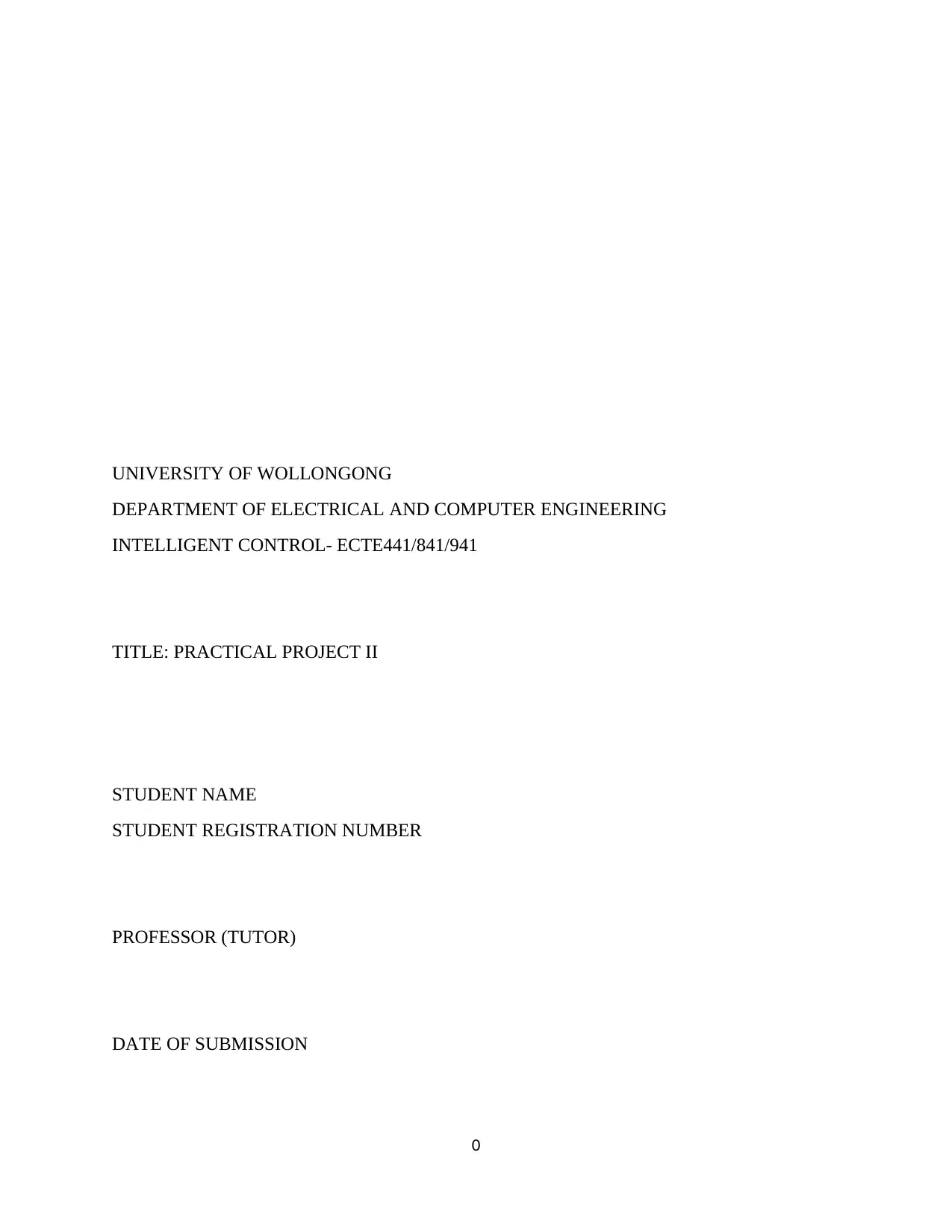
UNIVERSITY OF WOLLONGONG
DEPARTMENT OF ELECTRICAL AND COMPUTER ENGINEERING
INTELLIGENT CONTROL- ECTE441/841/941
TITLE: PRACTICAL PROJECT II
STUDENT NAME
STUDENT REGISTRATION NUMBER
PROFESSOR (TUTOR)
DATE OF SUBMISSION
0
DEPARTMENT OF ELECTRICAL AND COMPUTER ENGINEERING
INTELLIGENT CONTROL- ECTE441/841/941
TITLE: PRACTICAL PROJECT II
STUDENT NAME
STUDENT REGISTRATION NUMBER
PROFESSOR (TUTOR)
DATE OF SUBMISSION
0
Paraphrase This Document
Need a fresh take? Get an instant paraphrase of this document with our AI Paraphraser
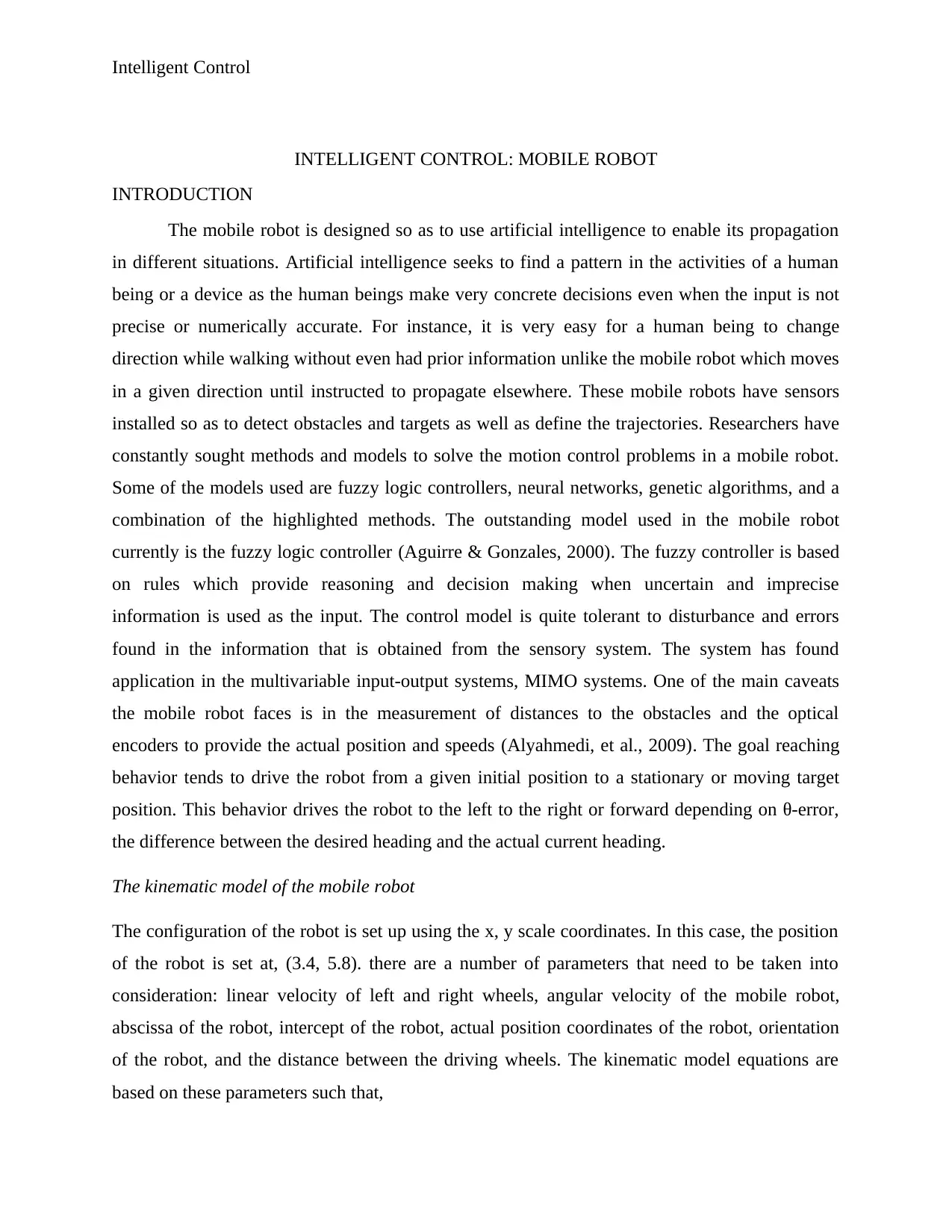
Intelligent Control
INTELLIGENT CONTROL: MOBILE ROBOT
INTRODUCTION
The mobile robot is designed so as to use artificial intelligence to enable its propagation
in different situations. Artificial intelligence seeks to find a pattern in the activities of a human
being or a device as the human beings make very concrete decisions even when the input is not
precise or numerically accurate. For instance, it is very easy for a human being to change
direction while walking without even had prior information unlike the mobile robot which moves
in a given direction until instructed to propagate elsewhere. These mobile robots have sensors
installed so as to detect obstacles and targets as well as define the trajectories. Researchers have
constantly sought methods and models to solve the motion control problems in a mobile robot.
Some of the models used are fuzzy logic controllers, neural networks, genetic algorithms, and a
combination of the highlighted methods. The outstanding model used in the mobile robot
currently is the fuzzy logic controller (Aguirre & Gonzales, 2000). The fuzzy controller is based
on rules which provide reasoning and decision making when uncertain and imprecise
information is used as the input. The control model is quite tolerant to disturbance and errors
found in the information that is obtained from the sensory system. The system has found
application in the multivariable input-output systems, MIMO systems. One of the main caveats
the mobile robot faces is in the measurement of distances to the obstacles and the optical
encoders to provide the actual position and speeds (Alyahmedi, et al., 2009). The goal reaching
behavior tends to drive the robot from a given initial position to a stationary or moving target
position. This behavior drives the robot to the left to the right or forward depending on θ-error,
the difference between the desired heading and the actual current heading.
The kinematic model of the mobile robot
The configuration of the robot is set up using the x, y scale coordinates. In this case, the position
of the robot is set at, (3.4, 5.8). there are a number of parameters that need to be taken into
consideration: linear velocity of left and right wheels, angular velocity of the mobile robot,
abscissa of the robot, intercept of the robot, actual position coordinates of the robot, orientation
of the robot, and the distance between the driving wheels. The kinematic model equations are
based on these parameters such that,
INTELLIGENT CONTROL: MOBILE ROBOT
INTRODUCTION
The mobile robot is designed so as to use artificial intelligence to enable its propagation
in different situations. Artificial intelligence seeks to find a pattern in the activities of a human
being or a device as the human beings make very concrete decisions even when the input is not
precise or numerically accurate. For instance, it is very easy for a human being to change
direction while walking without even had prior information unlike the mobile robot which moves
in a given direction until instructed to propagate elsewhere. These mobile robots have sensors
installed so as to detect obstacles and targets as well as define the trajectories. Researchers have
constantly sought methods and models to solve the motion control problems in a mobile robot.
Some of the models used are fuzzy logic controllers, neural networks, genetic algorithms, and a
combination of the highlighted methods. The outstanding model used in the mobile robot
currently is the fuzzy logic controller (Aguirre & Gonzales, 2000). The fuzzy controller is based
on rules which provide reasoning and decision making when uncertain and imprecise
information is used as the input. The control model is quite tolerant to disturbance and errors
found in the information that is obtained from the sensory system. The system has found
application in the multivariable input-output systems, MIMO systems. One of the main caveats
the mobile robot faces is in the measurement of distances to the obstacles and the optical
encoders to provide the actual position and speeds (Alyahmedi, et al., 2009). The goal reaching
behavior tends to drive the robot from a given initial position to a stationary or moving target
position. This behavior drives the robot to the left to the right or forward depending on θ-error,
the difference between the desired heading and the actual current heading.
The kinematic model of the mobile robot
The configuration of the robot is set up using the x, y scale coordinates. In this case, the position
of the robot is set at, (3.4, 5.8). there are a number of parameters that need to be taken into
consideration: linear velocity of left and right wheels, angular velocity of the mobile robot,
abscissa of the robot, intercept of the robot, actual position coordinates of the robot, orientation
of the robot, and the distance between the driving wheels. The kinematic model equations are
based on these parameters such that,
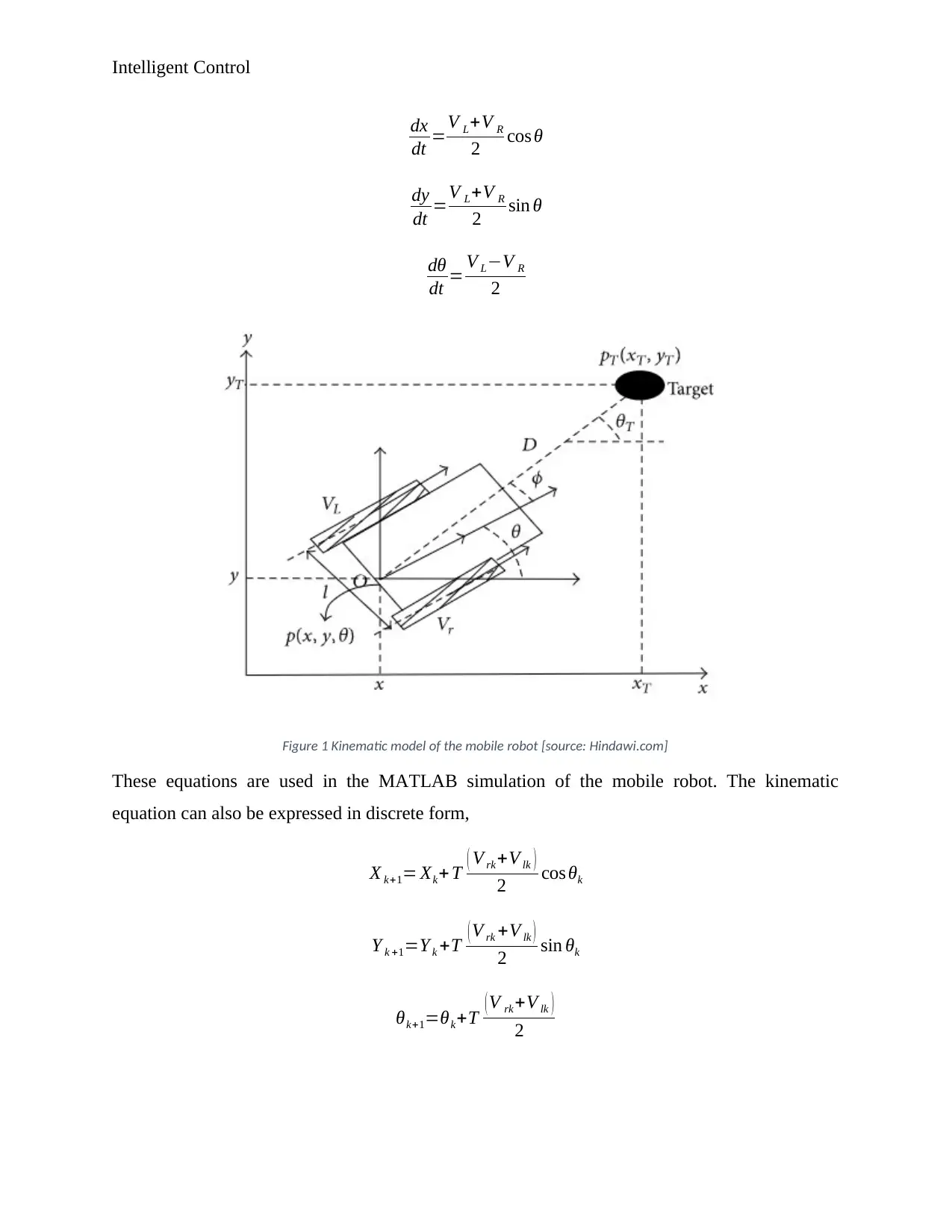
Intelligent Control
dx
dt =V L+V R
2 cos θ
dy
dt =V L+V R
2 sin θ
dθ
dt = V L−V R
2
Figure 1 Kinematic model of the mobile robot [source: Hindawi.com]
These equations are used in the MATLAB simulation of the mobile robot. The kinematic
equation can also be expressed in discrete form,
X k+1= Xk+ T ( V rk +V lk )
2 cos θk
Y k +1=Y k +T ( V rk +V lk )
2 sin θk
θk+1=θk+T ( V rk+V lk )
2
dx
dt =V L+V R
2 cos θ
dy
dt =V L+V R
2 sin θ
dθ
dt = V L−V R
2
Figure 1 Kinematic model of the mobile robot [source: Hindawi.com]
These equations are used in the MATLAB simulation of the mobile robot. The kinematic
equation can also be expressed in discrete form,
X k+1= Xk+ T ( V rk +V lk )
2 cos θk
Y k +1=Y k +T ( V rk +V lk )
2 sin θk
θk+1=θk+T ( V rk+V lk )
2
⊘ This is a preview!⊘
Do you want full access?
Subscribe today to unlock all pages.

Trusted by 1+ million students worldwide
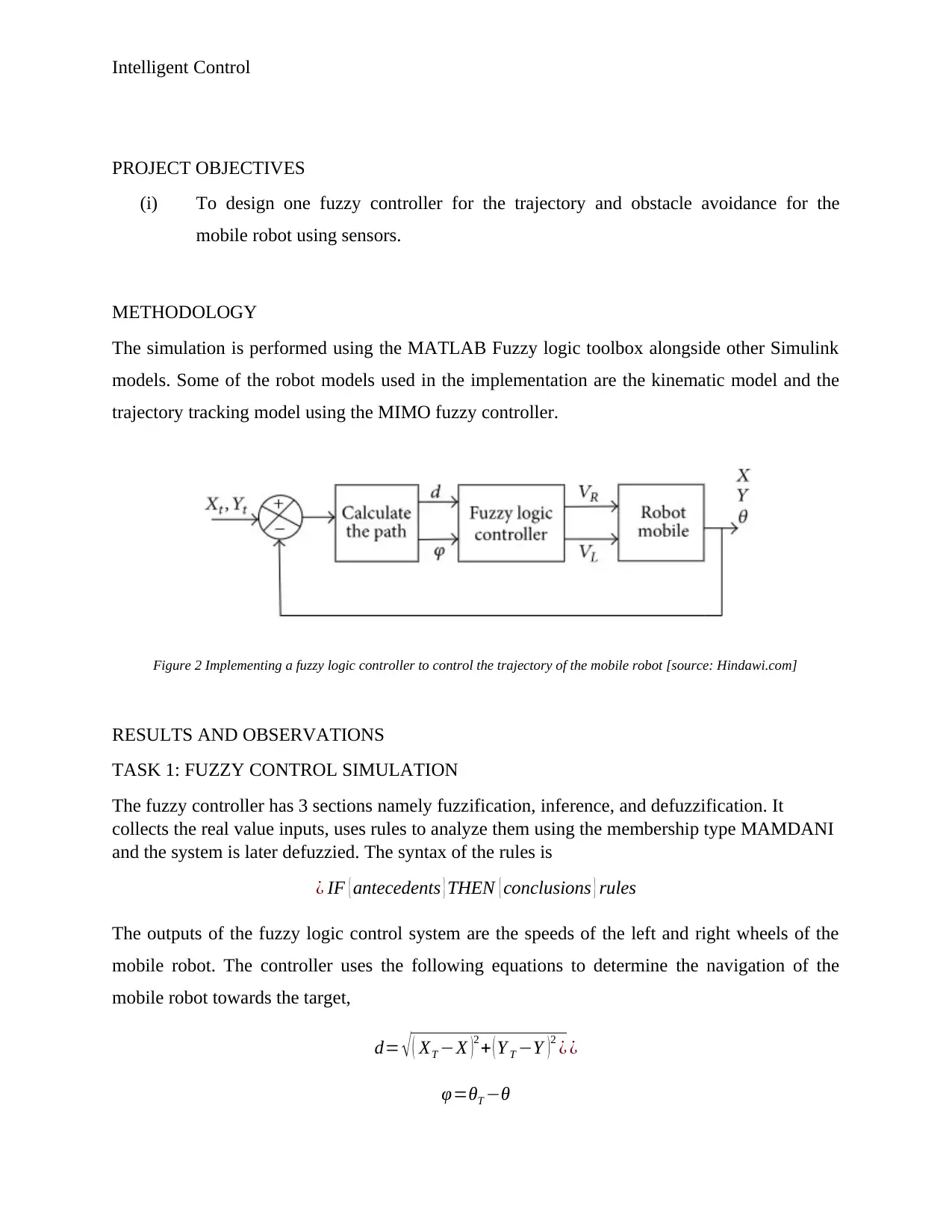
Intelligent Control
PROJECT OBJECTIVES
(i) To design one fuzzy controller for the trajectory and obstacle avoidance for the
mobile robot using sensors.
METHODOLOGY
The simulation is performed using the MATLAB Fuzzy logic toolbox alongside other Simulink
models. Some of the robot models used in the implementation are the kinematic model and the
trajectory tracking model using the MIMO fuzzy controller.
Figure 2 Implementing a fuzzy logic controller to control the trajectory of the mobile robot [source: Hindawi.com]
RESULTS AND OBSERVATIONS
TASK 1: FUZZY CONTROL SIMULATION
The fuzzy controller has 3 sections namely fuzzification, inference, and defuzzification. It
collects the real value inputs, uses rules to analyze them using the membership type MAMDANI
and the system is later defuzzied. The syntax of the rules is
¿ IF { antecedents } THEN { conclusions } rules
The outputs of the fuzzy logic control system are the speeds of the left and right wheels of the
mobile robot. The controller uses the following equations to determine the navigation of the
mobile robot towards the target,
d= √ ( XT −X )
2 + ( Y T −Y )
2 ¿ ¿
φ=θT −θ
PROJECT OBJECTIVES
(i) To design one fuzzy controller for the trajectory and obstacle avoidance for the
mobile robot using sensors.
METHODOLOGY
The simulation is performed using the MATLAB Fuzzy logic toolbox alongside other Simulink
models. Some of the robot models used in the implementation are the kinematic model and the
trajectory tracking model using the MIMO fuzzy controller.
Figure 2 Implementing a fuzzy logic controller to control the trajectory of the mobile robot [source: Hindawi.com]
RESULTS AND OBSERVATIONS
TASK 1: FUZZY CONTROL SIMULATION
The fuzzy controller has 3 sections namely fuzzification, inference, and defuzzification. It
collects the real value inputs, uses rules to analyze them using the membership type MAMDANI
and the system is later defuzzied. The syntax of the rules is
¿ IF { antecedents } THEN { conclusions } rules
The outputs of the fuzzy logic control system are the speeds of the left and right wheels of the
mobile robot. The controller uses the following equations to determine the navigation of the
mobile robot towards the target,
d= √ ( XT −X )
2 + ( Y T −Y )
2 ¿ ¿
φ=θT −θ
Paraphrase This Document
Need a fresh take? Get an instant paraphrase of this document with our AI Paraphraser
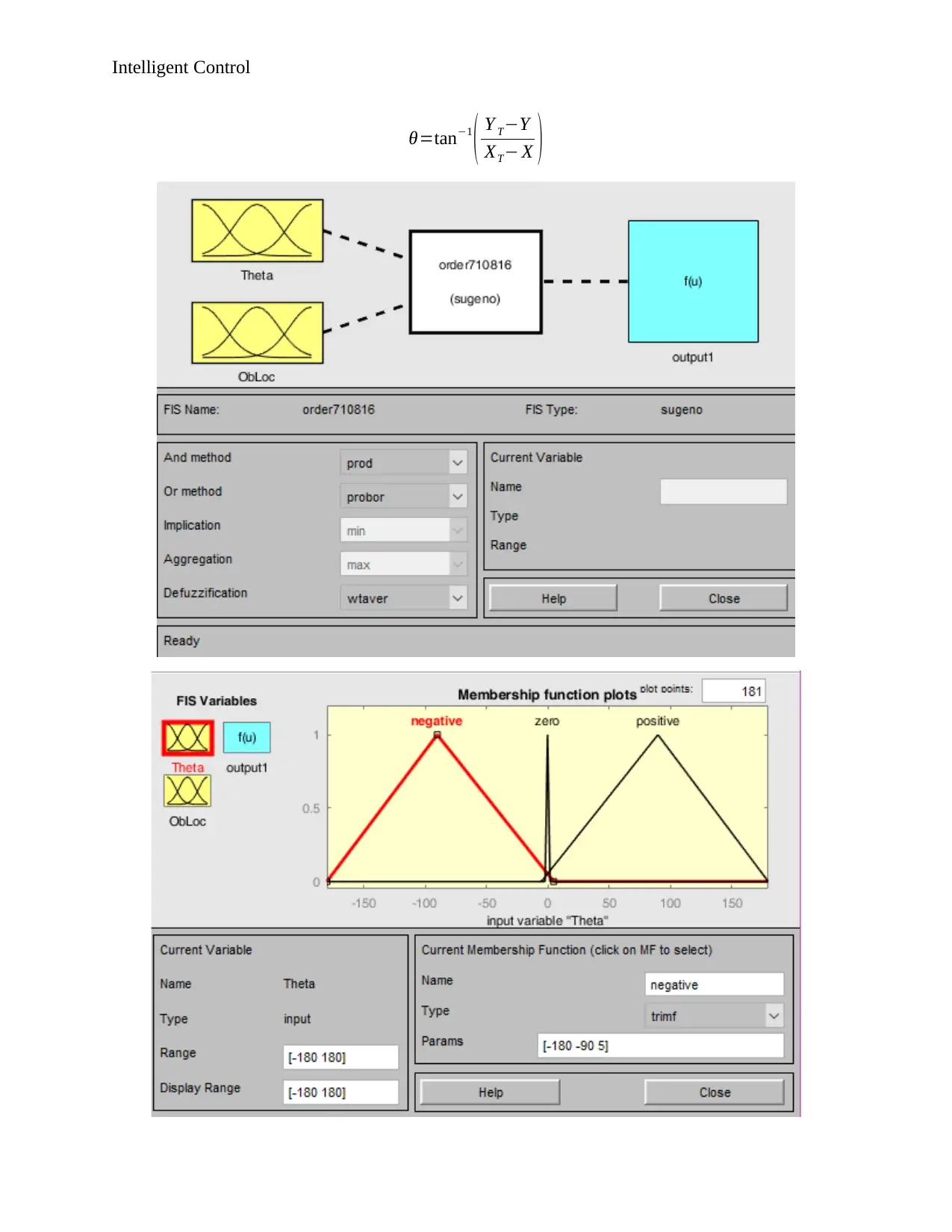
Intelligent Control
θ=tan−1
( Y T−Y
XT− X )
θ=tan−1
( Y T−Y
XT− X )
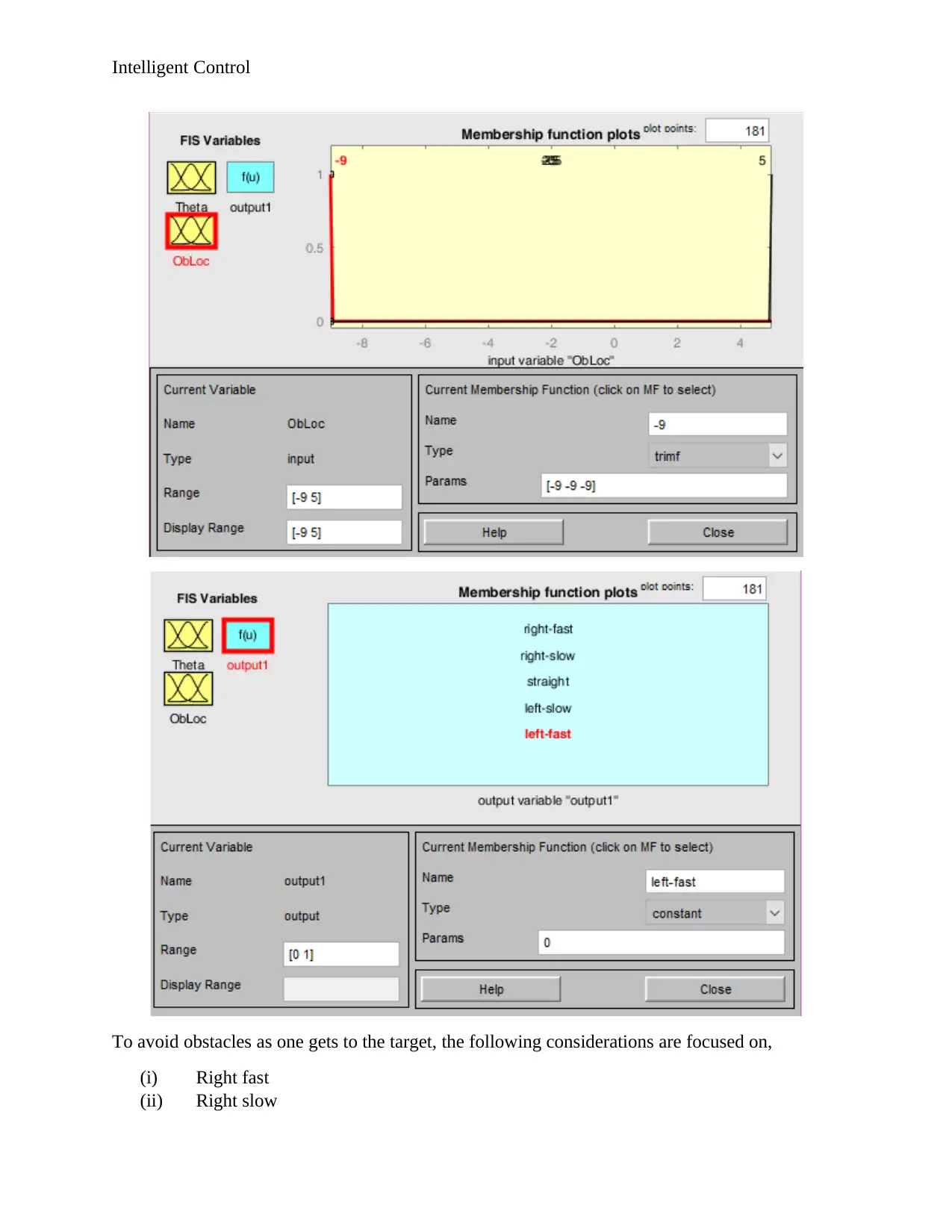
Intelligent Control
To avoid obstacles as one gets to the target, the following considerations are focused on,
(i) Right fast
(ii) Right slow
To avoid obstacles as one gets to the target, the following considerations are focused on,
(i) Right fast
(ii) Right slow
⊘ This is a preview!⊘
Do you want full access?
Subscribe today to unlock all pages.

Trusted by 1+ million students worldwide
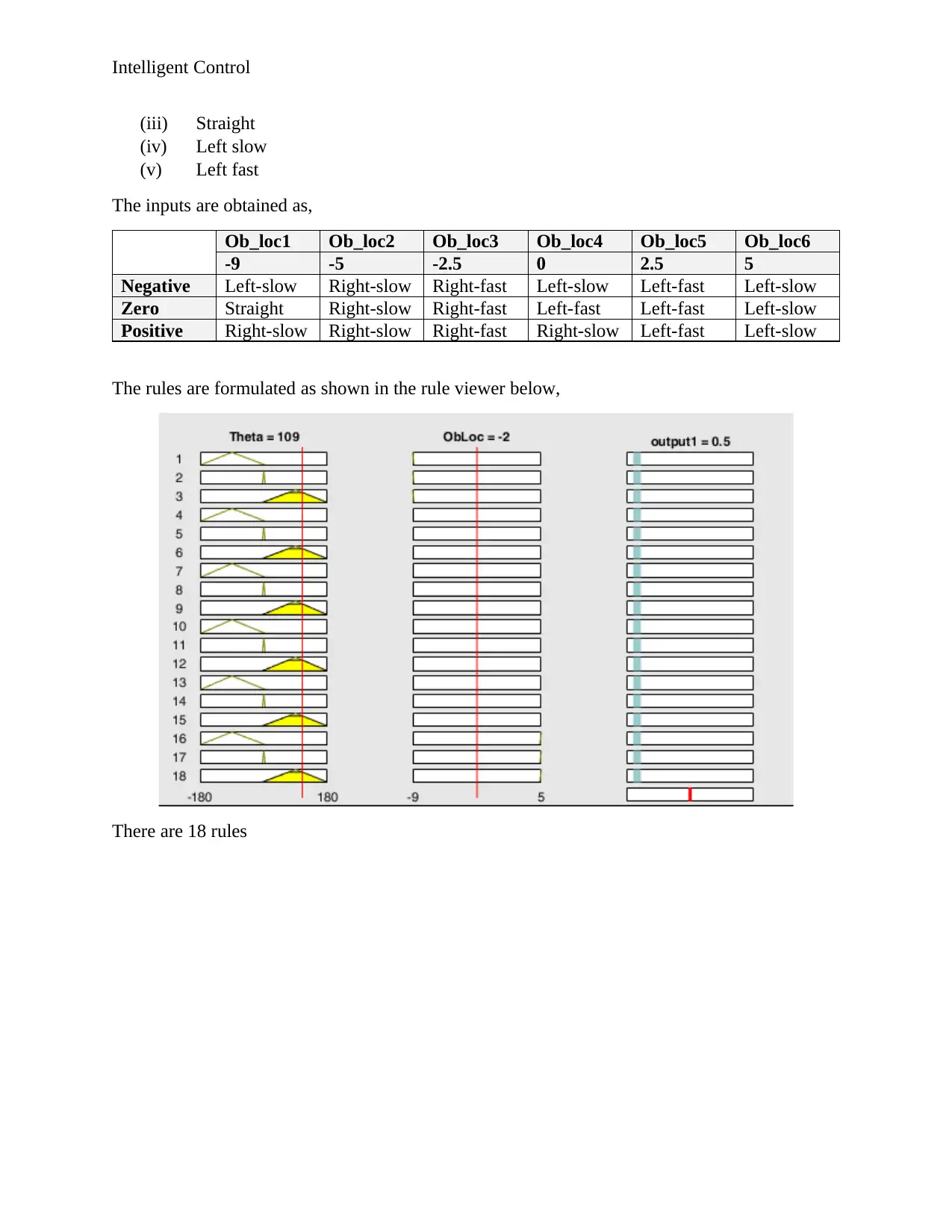
Intelligent Control
(iii) Straight
(iv) Left slow
(v) Left fast
The inputs are obtained as,
Ob_loc1 Ob_loc2 Ob_loc3 Ob_loc4 Ob_loc5 Ob_loc6
-9 -5 -2.5 0 2.5 5
Negative Left-slow Right-slow Right-fast Left-slow Left-fast Left-slow
Zero Straight Right-slow Right-fast Left-fast Left-fast Left-slow
Positive Right-slow Right-slow Right-fast Right-slow Left-fast Left-slow
The rules are formulated as shown in the rule viewer below,
There are 18 rules
(iii) Straight
(iv) Left slow
(v) Left fast
The inputs are obtained as,
Ob_loc1 Ob_loc2 Ob_loc3 Ob_loc4 Ob_loc5 Ob_loc6
-9 -5 -2.5 0 2.5 5
Negative Left-slow Right-slow Right-fast Left-slow Left-fast Left-slow
Zero Straight Right-slow Right-fast Left-fast Left-fast Left-slow
Positive Right-slow Right-slow Right-fast Right-slow Left-fast Left-slow
The rules are formulated as shown in the rule viewer below,
There are 18 rules
Paraphrase This Document
Need a fresh take? Get an instant paraphrase of this document with our AI Paraphraser
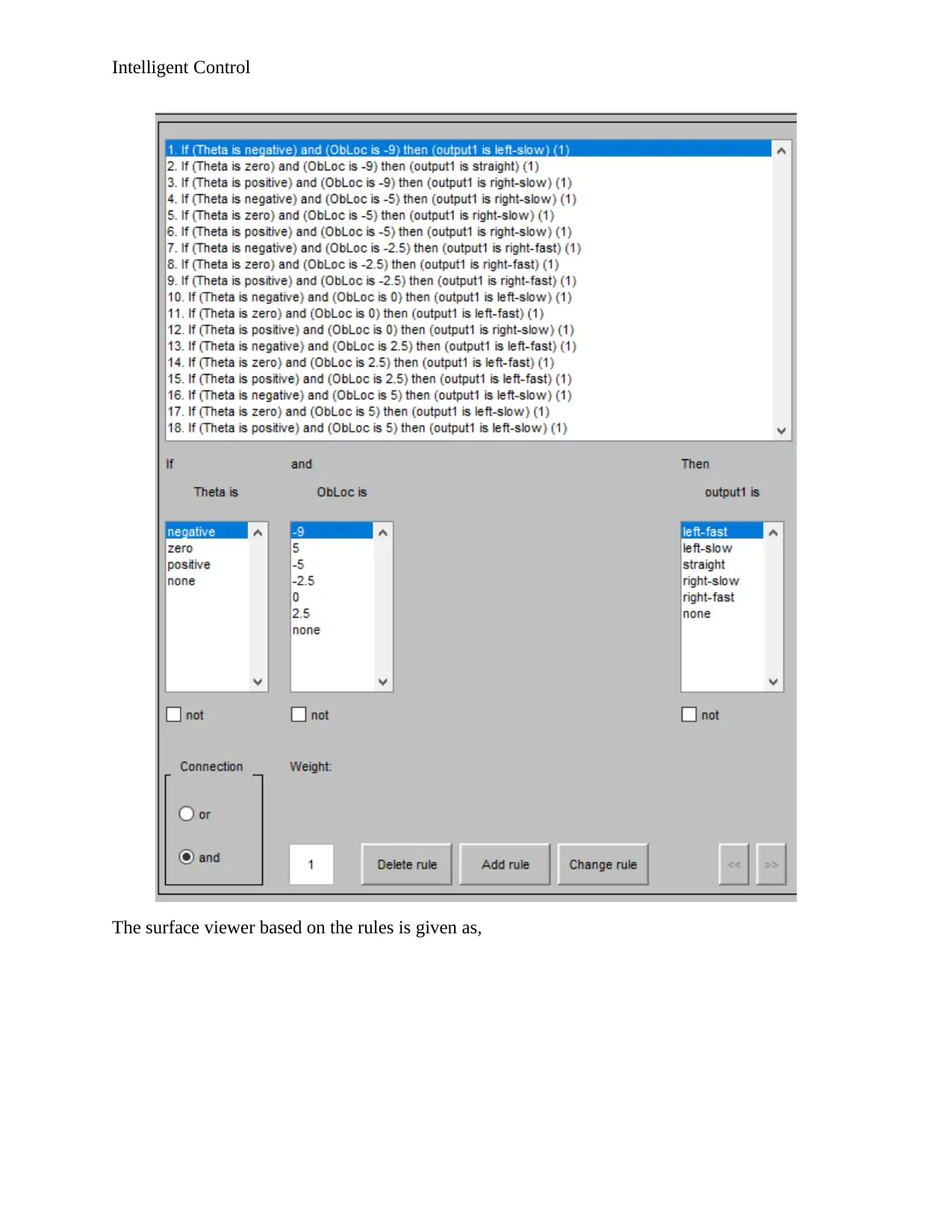
Intelligent Control
The surface viewer based on the rules is given as,
The surface viewer based on the rules is given as,
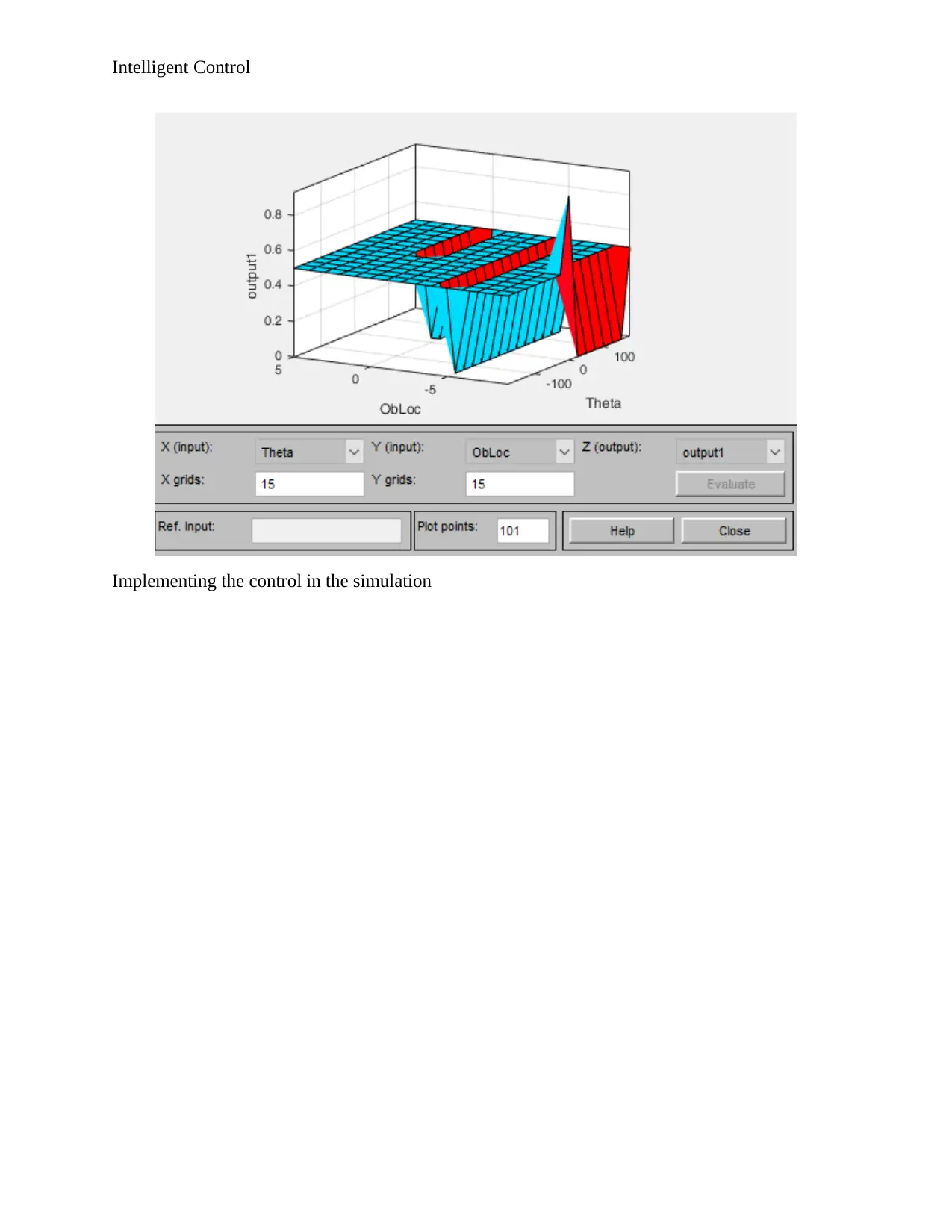
Intelligent Control
Implementing the control in the simulation
Implementing the control in the simulation
⊘ This is a preview!⊘
Do you want full access?
Subscribe today to unlock all pages.

Trusted by 1+ million students worldwide
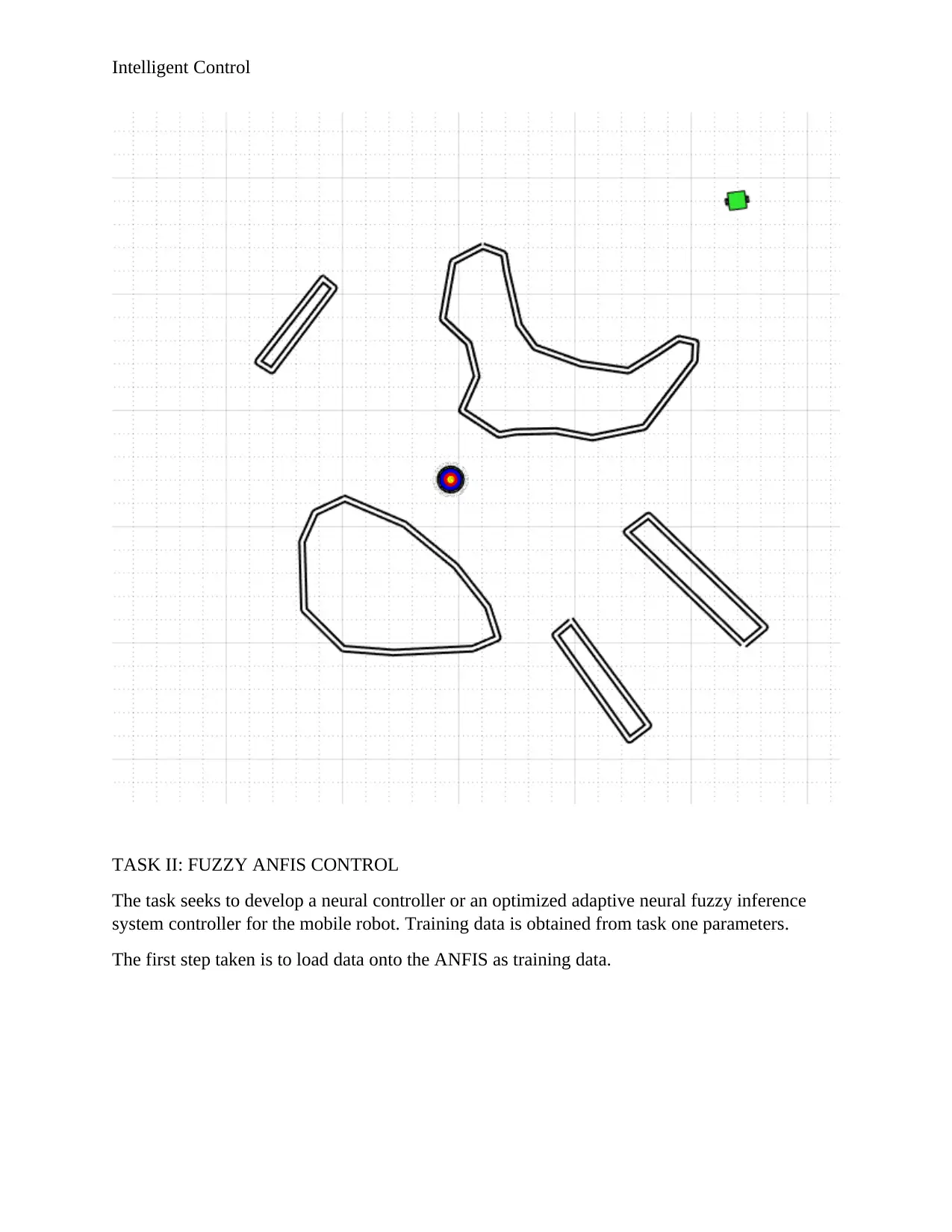
Intelligent Control
TASK II: FUZZY ANFIS CONTROL
The task seeks to develop a neural controller or an optimized adaptive neural fuzzy inference
system controller for the mobile robot. Training data is obtained from task one parameters.
The first step taken is to load data onto the ANFIS as training data.
TASK II: FUZZY ANFIS CONTROL
The task seeks to develop a neural controller or an optimized adaptive neural fuzzy inference
system controller for the mobile robot. Training data is obtained from task one parameters.
The first step taken is to load data onto the ANFIS as training data.
Paraphrase This Document
Need a fresh take? Get an instant paraphrase of this document with our AI Paraphraser
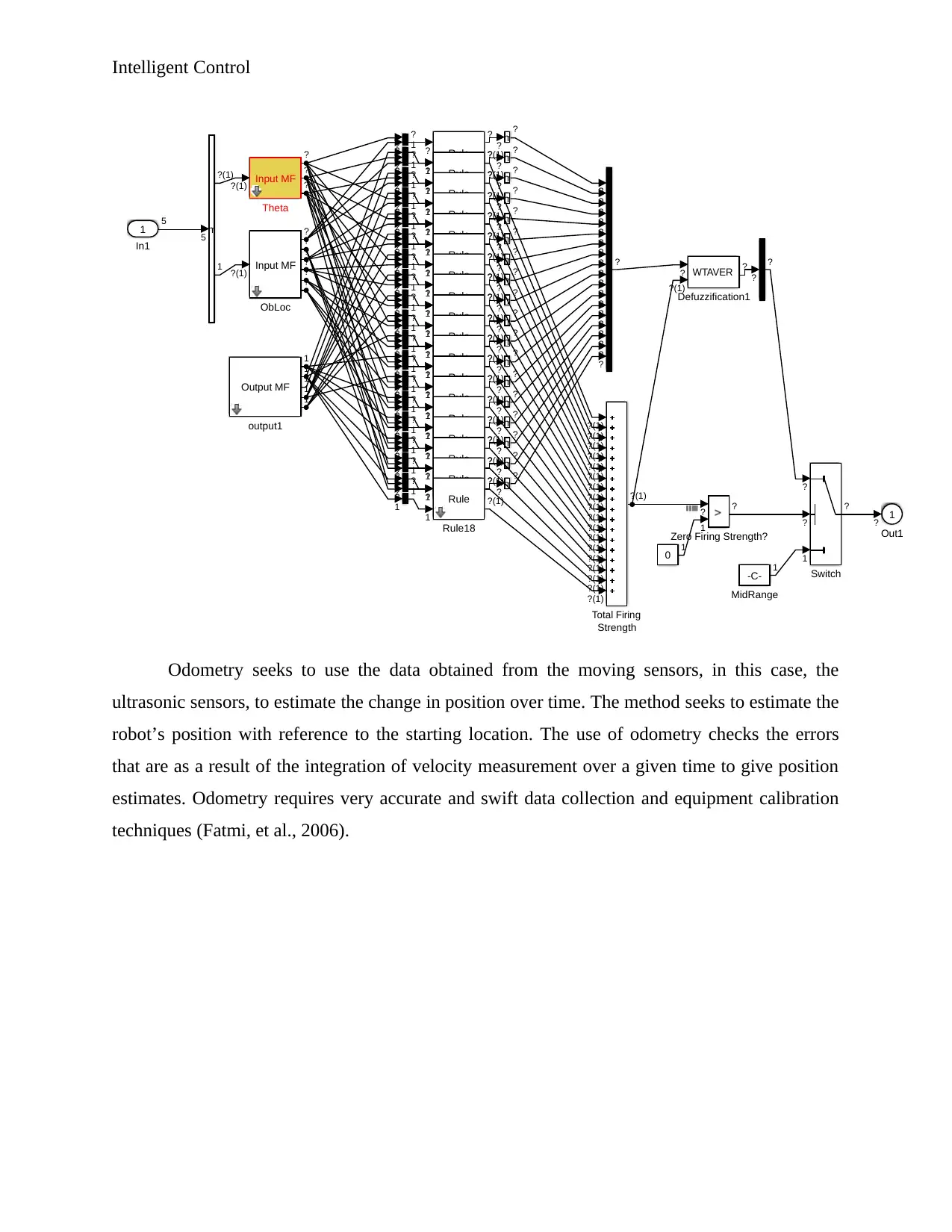
Intelligent Control
1
Out1
?
1
In1
5 Demux
5
?(1)
1
Input MF
Theta
??(1)
?
?
Input MF
ObLoc
?(1)
?
?
?
?
?
?
Output MF
output1
1
1
1
1
1
?
?
?
?
?
?
?
?
?
?
?
?
?
?
?
?
?
?
?
Total Firing
Strength
?(1)
?(1)
?(1)
?(1)
?(1)
?(1)
?(1)
?(1)
?(1)
?(1)
?(1)
?(1)
?(1)
?(1)
?(1)
?(1)
?(1)
?(1)
?(1)
?
?
?
1
1 Rule
Rule1
1
?
?
?(1)
Demux
?
?
?
?
?
1
1 Rule
Rule2
?
?
1
?(1)
Demux
?
?
?
?
? 1
1 Rule
Rule3
1
?
?
?(1)
Demux
?
?
?
?
?
1
1 Rule
Rule4
1
?(1)?
?Demux
?
?
?
?
?
1
1 Rule
Rule5
1
?
?(1)?
Demux
?
?
?
?
?
1
1 Rule
Rule6
?
1
?(1)?
Demux
?
?
?
?
?
1
1 Rule
Rule7
? ?(1)
?
1
Demux
?
?
?
?
?
1
1 Rule
Rule8
?
1
? ?(1)
Demux
?
?
?
?
?
1
1 Rule
Rule9
? ?(1)
1
?Demux
?
?
?
?
?
1
1 Rule
Rule10
?
?
1
?(1)
Demux
?
?
?
?
?
1
1 Rule
Rule11
? ?(1)
?
1
Demux
?
?
?
?
?
1
1 Rule
Rule12
?(1)
?
1
?
Demux
?
?
?
?
?
1
1 Rule
Rule13
?
1
?
?(1)
Demux
?
?
?
?
?
1
1 Rule
Rule14
?
?
1
?(1)
Demux
?
?
?
?
? 1
1 Rule
Rule15
?
1
?
?(1)
Demux
?
?
?
?
?
1
1 Rule
Rule16
?
1
?
?(1)
Demux
?
?
?
?
?
1
1 Rule
Rule17
?(1)?
?
1
Demux
?
?
?
?
? 1
1 Rule
Rule18
?
?
?(1)
1
Demux
?
?
WTAVER
Defuzzification1
? ?
?(1)
?
?
Zero Firing Strength?
?
1
?
0 1
-C-
MidRange
1 Switch
1
?
?
?
Odometry seeks to use the data obtained from the moving sensors, in this case, the
ultrasonic sensors, to estimate the change in position over time. The method seeks to estimate the
robot’s position with reference to the starting location. The use of odometry checks the errors
that are as a result of the integration of velocity measurement over a given time to give position
estimates. Odometry requires very accurate and swift data collection and equipment calibration
techniques (Fatmi, et al., 2006).
1
Out1
?
1
In1
5 Demux
5
?(1)
1
Input MF
Theta
??(1)
?
?
Input MF
ObLoc
?(1)
?
?
?
?
?
?
Output MF
output1
1
1
1
1
1
?
?
?
?
?
?
?
?
?
?
?
?
?
?
?
?
?
?
?
Total Firing
Strength
?(1)
?(1)
?(1)
?(1)
?(1)
?(1)
?(1)
?(1)
?(1)
?(1)
?(1)
?(1)
?(1)
?(1)
?(1)
?(1)
?(1)
?(1)
?(1)
?
?
?
1
1 Rule
Rule1
1
?
?
?(1)
Demux
?
?
?
?
?
1
1 Rule
Rule2
?
?
1
?(1)
Demux
?
?
?
?
? 1
1 Rule
Rule3
1
?
?
?(1)
Demux
?
?
?
?
?
1
1 Rule
Rule4
1
?(1)?
?Demux
?
?
?
?
?
1
1 Rule
Rule5
1
?
?(1)?
Demux
?
?
?
?
?
1
1 Rule
Rule6
?
1
?(1)?
Demux
?
?
?
?
?
1
1 Rule
Rule7
? ?(1)
?
1
Demux
?
?
?
?
?
1
1 Rule
Rule8
?
1
? ?(1)
Demux
?
?
?
?
?
1
1 Rule
Rule9
? ?(1)
1
?Demux
?
?
?
?
?
1
1 Rule
Rule10
?
?
1
?(1)
Demux
?
?
?
?
?
1
1 Rule
Rule11
? ?(1)
?
1
Demux
?
?
?
?
?
1
1 Rule
Rule12
?(1)
?
1
?
Demux
?
?
?
?
?
1
1 Rule
Rule13
?
1
?
?(1)
Demux
?
?
?
?
?
1
1 Rule
Rule14
?
?
1
?(1)
Demux
?
?
?
?
? 1
1 Rule
Rule15
?
1
?
?(1)
Demux
?
?
?
?
?
1
1 Rule
Rule16
?
1
?
?(1)
Demux
?
?
?
?
?
1
1 Rule
Rule17
?(1)?
?
1
Demux
?
?
?
?
? 1
1 Rule
Rule18
?
?
?(1)
1
Demux
?
?
WTAVER
Defuzzification1
? ?
?(1)
?
?
Zero Firing Strength?
?
1
?
0 1
-C-
MidRange
1 Switch
1
?
?
?
Odometry seeks to use the data obtained from the moving sensors, in this case, the
ultrasonic sensors, to estimate the change in position over time. The method seeks to estimate the
robot’s position with reference to the starting location. The use of odometry checks the errors
that are as a result of the integration of velocity measurement over a given time to give position
estimates. Odometry requires very accurate and swift data collection and equipment calibration
techniques (Fatmi, et al., 2006).
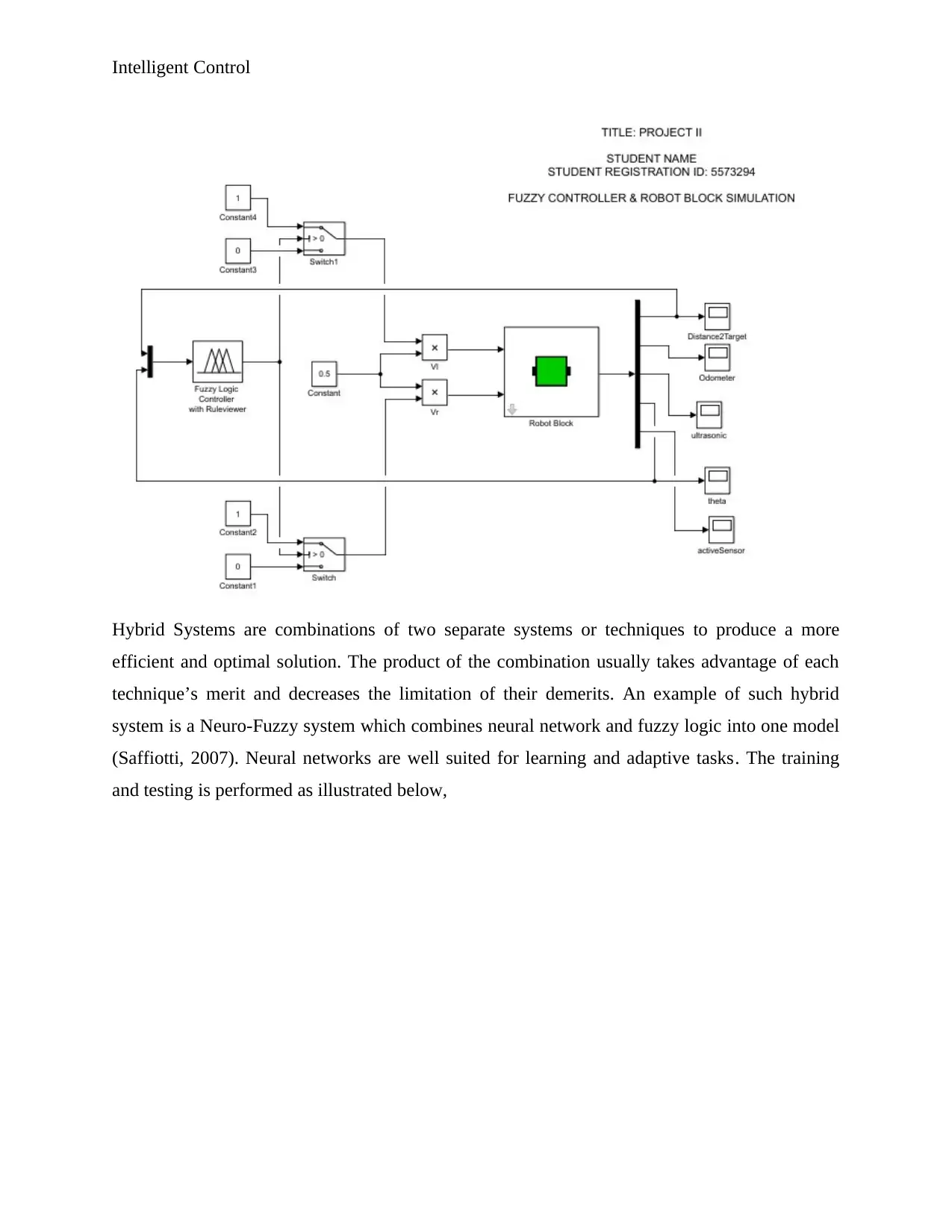
Intelligent Control
Hybrid Systems are combinations of two separate systems or techniques to produce a more
efficient and optimal solution. The product of the combination usually takes advantage of each
technique’s merit and decreases the limitation of their demerits. An example of such hybrid
system is a Neuro-Fuzzy system which combines neural network and fuzzy logic into one model
(Saffiotti, 2007). Neural networks are well suited for learning and adaptive tasks. The training
and testing is performed as illustrated below,
Hybrid Systems are combinations of two separate systems or techniques to produce a more
efficient and optimal solution. The product of the combination usually takes advantage of each
technique’s merit and decreases the limitation of their demerits. An example of such hybrid
system is a Neuro-Fuzzy system which combines neural network and fuzzy logic into one model
(Saffiotti, 2007). Neural networks are well suited for learning and adaptive tasks. The training
and testing is performed as illustrated below,
⊘ This is a preview!⊘
Do you want full access?
Subscribe today to unlock all pages.

Trusted by 1+ million students worldwide
1 out of 15
Your All-in-One AI-Powered Toolkit for Academic Success.
+13062052269
info@desklib.com
Available 24*7 on WhatsApp / Email
![[object Object]](/_next/static/media/star-bottom.7253800d.svg)
Unlock your academic potential
Copyright © 2020–2025 A2Z Services. All Rights Reserved. Developed and managed by ZUCOL.
